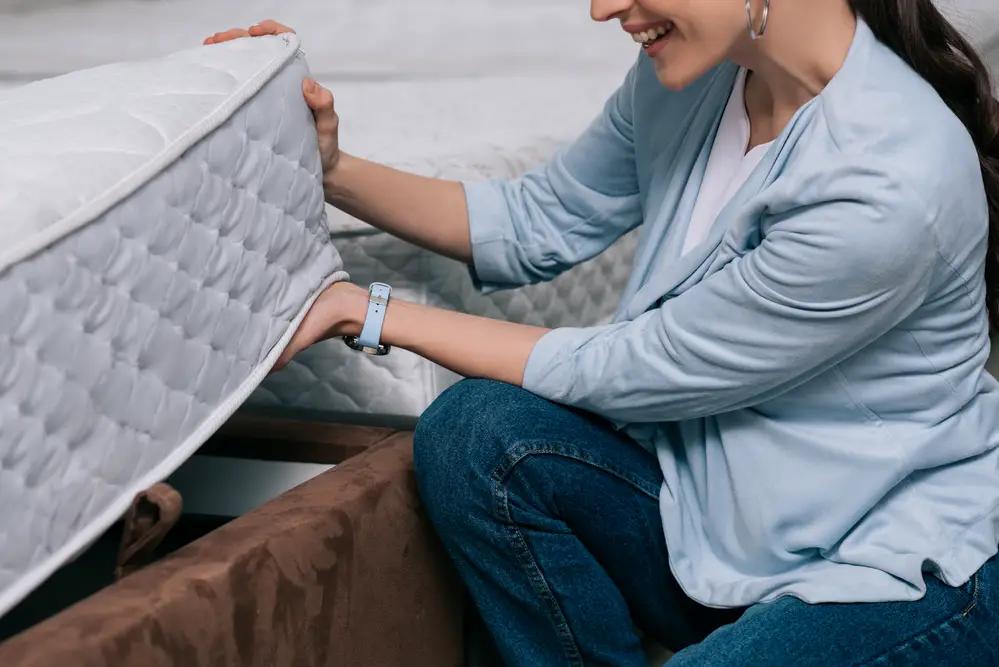Have you ever wondered if your mattress is gaining weight over time? The answer is yes, your mattress can get heavier over time. This is due to the accumulation of sweat, dead skin cells, and dust mites. In fact, your mattress could be up to 10 pounds heavier after just a few years of use.
Key Takeaways
- Mattresses can gain weight over time due to the accumulation of bodily fluids, dust mites, and bacteria.
- The materials used in the mattress can also contribute to weight gain as they break down and compress over time.
- Proper maintenance and cleaning can help manage mattress weight and extend its lifespan.
Factors that Contribute to Mattress Weight
When it comes to mattress weight, there are several factors that contribute to it. Understanding these factors can help you make informed decisions when it comes to purchasing a new mattress or maintaining an existing one.

Materials
The materials used in a mattress’s construction can have a significant impact on its weight and longevity.
For example, latex and high-density polyfoam can last a long time, while low-density polyfoam can wear out much more quickly.
Hybrid mattresses, which combine foam and innerspring coils, can also be heavier due to their complex construction.
Accumulation of Dust and Debris
Over time, mattresses can accumulate dust, debris, and other particles that can add to their weight.
Dust mites, which feed on dead skin cells, can also contribute to mattress weight gain. According to the Ohio State University, a typical used mattress can have anywhere from 100,000 to 10 million dust mites inside.
Moisture and Sweat
Moisture and sweat can also contribute to mattress weight gain. As you sleep, your body sweats, and this moisture can seep into your mattress. Over time, this can lead to mold and mildew growth, which can further add to the weight of your mattress.
Dead Skin Cells and Oil
Your body sheds dead skin cells and oil as you sleep, and these particles can accumulate in your mattress over time. This can attract dust mites and other allergens, which can further contribute to mattress weight gain.
Allergens and Bacteria
Allergens and bacteria can also contribute to mattress weight gain. Dust mite droppings, pet dander, and other allergens can build up in your mattress over time, leading to allergic reactions and other health issues. Bacteria can also grow in your mattress, which can lead to unpleasant odors and other problems.
To keep your mattress clean and reduce weight gain, it’s important to invest in a good mattress protector and to regularly vacuum and flip your mattress. Additionally, if you notice sagging or other signs of wear and tear, it may be time to invest in a new mattress.
Remember, the general guideline for mattress lifespan is around 7-10 years, but this can vary depending on factors such as mattress size, body weight, sleep position, and more. By taking care of your mattress and understanding the factors that contribute to weight gain, you can enjoy better sleep quality and overall health.
How Mattress Weight Changes Over Time
If you have ever wondered if your mattress is getting heavier over time, the answer is yes.
Mattresses gain weight as they absorb sweat, dead skin, and dust mites. In this section, we will explore how mattress weight changes over time and factors that affect it.

Lifespan of a Mattress
The lifespan of a mattress varies depending on the type and quality. According to the Ohio State University, innerspring mattresses typically last between 7-10 years, while foam mattresses can last up to 15 years.
However, this is just a general guideline, and factors such as wear and tear, sleep position, and body weight can affect the lifespan of your mattress.
Effects of Wear and Tear
As your mattress ages, it will naturally start to sag and lose its shape. This can result in discomfort, aches, and pains. Additionally, wear and tear can cause the mattress to become less supportive and less comfortable.
Sleep Position and Body Weight
Your sleep position and body weight can also affect how your mattress changes over time. For example, if you are a side sleeper, your mattress may develop more sagging in the hip and shoulder areas. Similarly, if you are heavier, your mattress may wear out more quickly.
To help you better understand how your sleep position and body weight can affect your mattress, here’s a table:
| Sleep Position | Body Weight | Mattress Type |
|---|---|---|
| Side Sleeper | Light | Foam |
| Side Sleeper | Heavy | Innerspring |
| Back Sleeper | Light | Foam |
| Back Sleeper | Heavy | Innerspring |
| Stomach Sleeper | Light | Foam |
| Stomach Sleeper | Heavy | Innerspring |
As you can see, the type of mattress that is best for you depends on your sleep position and body weight.
In conclusion, mattresses do get heavier over time as they absorb sweat, dead skin, and dust mites. The lifespan of a mattress varies depending on the type and quality, and factors such as wear and tear, sleep position, and body weight can affect how quickly your mattress wears out. To ensure optimal comfort and support, it is recommended that you replace your old mattress every 7-10 years for innerspring mattresses and every 10-15 years for foam mattresses.
How to Manage Mattress Weight
If you want to keep your mattress in good condition and prevent it from getting heavier over time, there are a few things you can do. Here are some tips to help you manage the weight of your mattress.
Vacuuming and Cleaning
One of the easiest ways to keep your mattress from getting heavier is to vacuum it regularly. This will help remove any dust, dirt, or other debris that may be accumulating on the surface of your mattress. You can use a handheld vacuum or a regular vacuum with an upholstery attachment to clean your mattress.
In addition to vacuuming, you should also clean any spills or stains on your mattress as soon as they happen. Use a damp cloth and a mild detergent to gently clean the affected area. Be sure to let the mattress dry completely before putting any sheets or bedding back on it.
Flipping and Rotating
Another way to manage the weight of your mattress is to flip and rotate it regularly. This is especially important for innerspring mattresses, which can develop sagging or indentations over time if you sleep in the same spot every night.
Most manufacturers recommend flipping and rotating your mattress every three to six months. You can use a mattress topper to help protect your mattress and extend its lifespan.
Using a Mattress Protector
Using a mattress protector is another way to manage the weight of your mattress. A mattress protector can help prevent spills, stains, and dust mites from getting inside your mattress. It can also help keep your mattress clean and fresh.
There are many different types of mattress protectors available, including waterproof, hypoallergenic, and breathable options. Look for a mattress protector that fits your mattress snugly and is easy to remove and wash.
By following these tips, you can help manage the weight of your mattress and keep it in good condition for years to come.
Conclusion
In summary, mattresses do get heavier over time due to the accumulation of bodily fluids, dead skin cells, dust mites, fungi, pollen, and dander. As a result, you may notice that your mattress feels heavier and more difficult to move as it ages.

